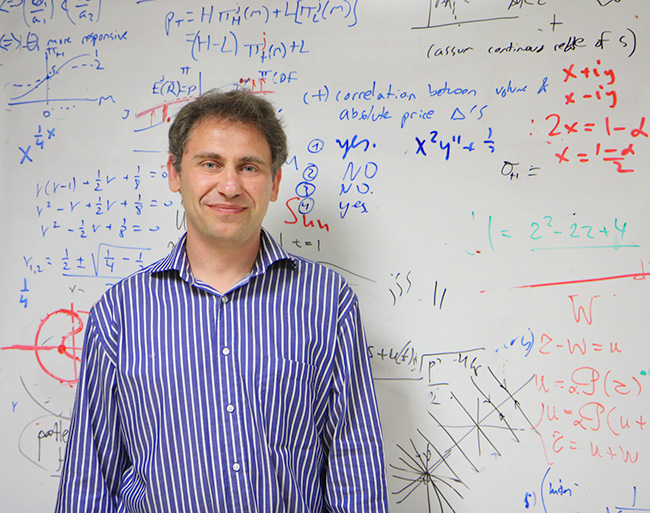At first glance, populations of wild animals might seem to have nothing in common with laser-based communications devices, and rivers to have little to do with macroeconomic theory.
But they all can be modeled using methods of dynamical systems theory.

Dr. Dmitry Rachinskiy came to UT Dallas from University College Cork in Ireland.
“In my field of work, I try to mathematically describe dynamical systems and processes,” said Dr. Dmitry Rachinskiy, a professor of mathematical sciences who recently joined the UT Dallas faculty. By applying principles of mathematics to such systems, which change over time, Rachinskiy said scientists and engineers can better understand problems and phenomena in biology, physics, chemistry, technology, geosciences and economics, among other fields.
“This research is applicable to many different areas, for example, population dynamics, where you have a community of several species forming an ecological system,” Rachinskiy explained. “The number of animals changes over time, and you may want to predict what those changes will be and how to control them. Dynamical systems theory gives you a means to formulate a mathematical model that will help predict how different factors affect population numbers.”
An author of more than 100 research publications, Rachinskiy was a lecturer in the Department of Applied Mathematics at University College Cork, Ireland, before joining the UT Dallas faculty. He also has held research positions at the Weierstrass Institute for Applied Analysis and Stochastics in Berlin, the Technical University in Munich, and the Russian Academy of Sciences.
Dr. Dmitry Rachinskiy
TITLE: Professor of mathematical sciences
RESEARCH INTERESTS: Nonlinear dynamical systems and bifurcation theory; mathematical theory of systems with hysteresis; applied mathematical modeling
PREVIOUS INSTITUTION: College lecturer, Dept. of Applied Mathematics, University College Cork, Ireland
His experience includes developing mathematical models for laser devices used for transmitting information through optical connections.
“Mathematical modeling helps engineers design and optimize these lasers,” he said. “The nature of applied mathematical research is that you can create a valuable model only if you communicate with people in another discipline. This is what makes research interesting and very attractive to me.”
Rachinskiy also has worked on mathematical models of a phenomenon called hysteresis, which is a property of certain materials and systems to “remember.”
“One example of hysteresis is a shape-memory material,” Rachinskiy said. “You deform this material, then heat it, and the material comes back to its original shape. This is a property that has ‘smart’ technological applications.”
While a researcher in Ireland, Rachinskiy worked on hysteresis models with a group of engineers that included soil scientists and hydrologists.
“There are prominent hysteresis effects in many kinds of flow, like oil or water, where fluid travels through porous media such as soil, which acts like a sponge,” Rachinskiy said. Hysteresis effects also occur in river beds, where the flow might be strong or weak. In Ireland, this is often due to tidal effects, where the water from the ocean comes into a river and goes out again twice a day.
“But the path of the water is not random. The soil ‘remembers’ where the water was before,” Rachinskiy said. “This also is a manifestation of hysteresis.”
Rachinskiy and his colleagues also have applied mathematical models of hysteresis to macroeconomics.
Rachinskiy earned a master’s degree in applied math and physics and a doctorate in mathematics from the Moscow Institute of Physics and Technology, as well as a Doctor of Science degree in applied mathematics from the Institute for Control Problems at the Russian Academy of Sciences. He said the potential for collaboration at UT Dallas was a major factor in his decision to join the faculty.
“There are very interesting research possibilities here,” he said. “The math department in particular is growing and has faculty with quite diverse expertise. UT Dallas is growing very fast, and its aspirations are big. It’s an exciting place to be.”